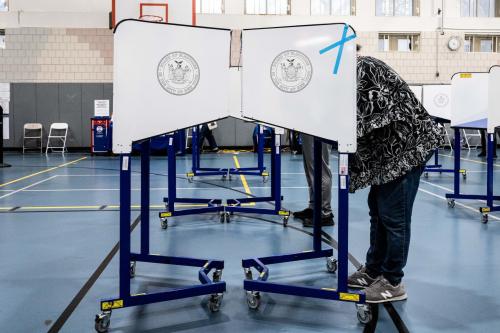A version of this op-ed originally appeared in the Guardian.
The middle class might be developing a bit of a complex about its size. After all, rarely a month goes by without a headline about how it is “shrinking.” Sometimes the preferred verb is “hollowing out,” but that doesn’t sound too great either.
The latest shrinkage alert comes from the OECD, in a new report showing that the middle class now accounts for just 61 percent of the populations of member countries, down from 64 percent in the mid-80s.
But is a smaller middle class a bad thing? It depends. The middle class might be contracting for three very different reasons: because there are more people on high incomes; because there are more people on low incomes; or because there are more people on both high and low incomes.
Across the OECD as a whole, about two thirds of the drop in middle class population share results from a rise in the lower-income population: bad news, for sure. But this varies a lot across nations. And that matters a lot in terms of how we should interpret a drop in the size of the middle class.
In many countries, the middle class shrinkage results from increased numbers of people at both tails—in other words, there are more rich people and more poor people. This is true, for example, of Sweden, Germany and Canada—all of whom have seen bigger-than-average drops.
But it is not true in all places. In the U.S., it is mostly a rise in the proportion of high-income households that is causing the middle class to shrink. The Spanish middle class has shrunk by a similar amount—but entirely because of an increase in the size of the low-income population. In France the middle class has grown, mostly because there are fewer low-income people. Great! In Ireland the middle class has also grown, but mostly because there are fewer high-income people. Not so great?
The same pattern can be seen in U.S. cities. Between 2000 and 2014, the middle class shrank by about the same amount in San Francisco (53 percent to 48 percent) as in Detroit (55 percent to 51 percent). But it was for opposite reasons: in San Francisco because more people got rich; in Detroit because more people got poor. To say simply that the middle class is “shrinking” in each place doesn’t tell us very much.
Definitions really matter here. And there is no agreed definition for the middle class. As the late, great inequality expert Anthony Atkinson put it, “There is…a certain penumbra surrounding the definition of middle class.” That is putting it politely. Almost every scholar adopts their own definition of the middle class, often with big consequences for their results, as Atkinson himself showed in his work with Andrea Brandolini.
The OECD define the middle class as a range around the median household income, specifically between 75 percent to 200 percent. A middle-class income in the U.S., then, is one from $23,000 to $62,000; in the UK, $16,000 to $42,000; in Mexico, $4,000 to $10,000. This median-pegged approach comes in many varieties. There is the 66 percent to 200 percent range adopted by the Pew Research Center. The late Alan Krueger urged the use of an income band of 50 percent to 150 percent. Lester Thurow argued for a narrower band from 75 percent to 125 percent. Some prefer an upper band of 250 percent or even 300 percent. Take your pick. It’s basically a social science smorgasbord.
The key point is that under any of these median-pegged definitions, the middle class can grow or shrink. The more people are “clustered” around the median, the bigger the middle class. The more people are on low incomes and high incomes, the smaller the middle class. The size of the middle class, on a median-pegged definition, is then simply a proxy for income inequality. (This is one of many reasons I prefer to use a fixed income range to define the middle class, specifically the middle 60 percent).
So if the main reason the U.S. middle class is shrinking is that more people are affluent, is that a bad thing? That depends on whether you think inequality is a bad thing—and specifically, inequality driven by a stretching of the income distribution towards the top. As it happens, inequality of this kind is a bad thing. It is bad because the middle class judge their own progress against that of the richer folks and feel left behind. It is bad because those with high and rising incomes become disconnected—physically and psychologically—from the people further down the ladder, undermining support for redistribution. It is bad because, as CUNY’s Janet Gornick points out, richer families can effectively secede from public services such as education and transport, rendering them more vulnerable and less diverse.
But reasonable people can disagree on this point. If we want to argue about income inequality, we should do so clearly and directly, rather than doing so at one remove through a debate about middle class size.




Commentary
Op-edThe condition of the middle class matters more than its size
April 15, 2019